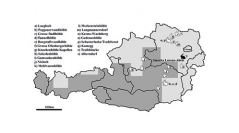

 Comptes Rendus Palevol
14 (5) - Pages 403-410
Comptes Rendus Palevol
14 (5) - Pages 403-410The new archaeological and palaeontological site of Smrcka Lorenz-Abris yielded three different leporid species in stratigraphical sequence, mirroring the effect of environmental changes and the influence of humans in this area. Lepus timidus is a species with a wide Late Pleistocene distribution, but disappeared in the Vienna Basin at the end of the Pleistocene. Lepus europaeus appeared in the Holocene and became dominant in lower altitudes in Austria. Interspecific competition as well as anthropogenic and natural environmental changes are the main factors that caused this replacement. At Smrcka Lorenz-Abris, L. europaeus became dominant around 7000 a BP. This site yielded the last evidence of a mountain hare in the Vienna Basin, with a preserved lower jaw that was dated to be from around 14,000 a BP. The most recent immigrant is Oryctolagus cuniculus, which was introduced to Austria, and only found in the upper parts of the section.
Lepus , Oryctolagus, Taphonomy, Climate change, Archaeozoology